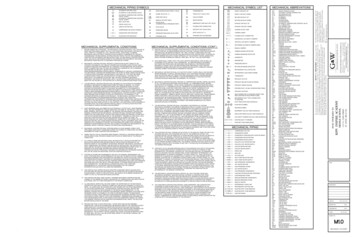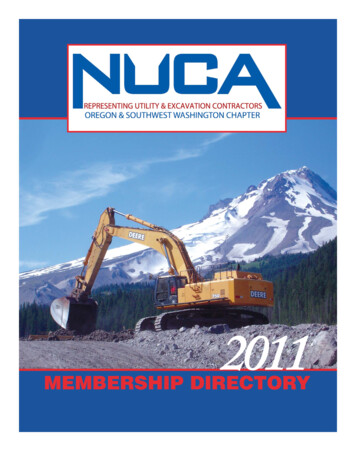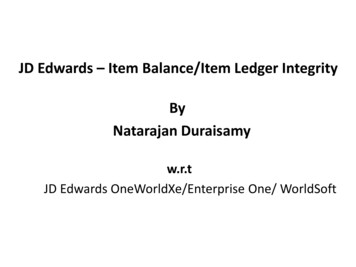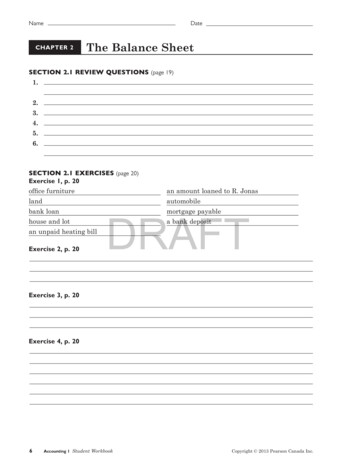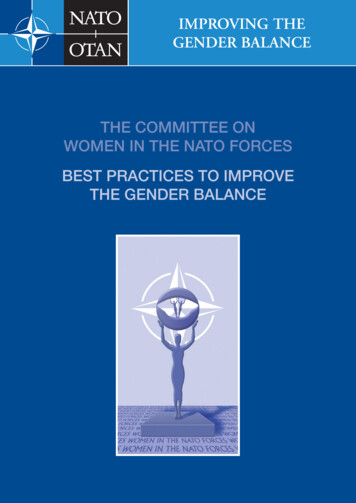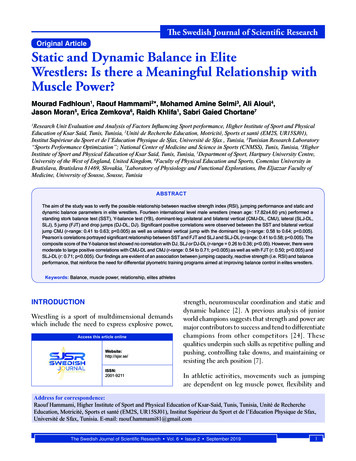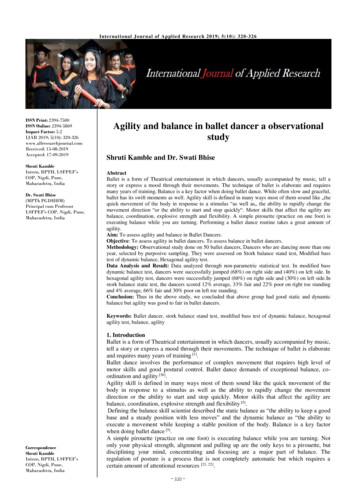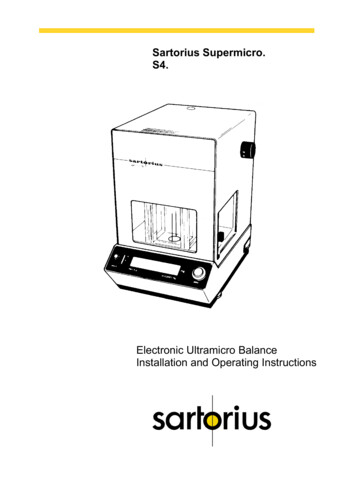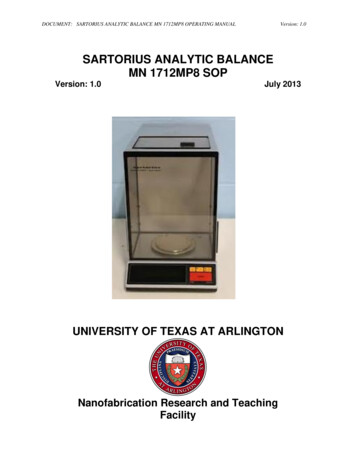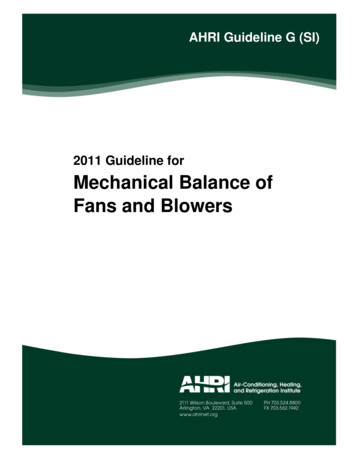
Transcription
AHRI Guideline G (SI)2011 Guideline forMechanical Balance ofFans and Blowers
IMPORTANTSAFETY DISCLAIMERAHRI does not set safety standards and does not certify or guarantee the safety of any products, components orsystems designed, tested, rated, installed or operated in accordance with this standard/guideline. It is stronglyrecommended that products be designed, constructed, assembled, installed and operated in accordance withnationally recognized safety standards and code requirements appropriate for products covered by thisstandard/guideline.AHRI uses its best efforts to develop standards/guidelines employing state-of-the-art and accepted industrypractices. AHRI does not certify or guarantee that any tests conducted under the standards/guidelines will notbe non-hazardous or free from risk.Note:This guideline supersedes AHRI Guideline G-2002.For I-P, see AHRI Guideline G (I-P)-2001.Price 10.00 (M) 20.00 (NM)Printed in U.S.A. Copyright 2011, by Air-Conditioning,Heating, and Refrigeration InstituteRegistered United States Patent and Trademark Office
TABLE OF CONTENTSSECTIONPAGESection 1.Purpose.1Section 2.Scope .1Section 3.Definitions.1Section 4.System Vibration .3Section 5.Instrumentation and Measurement .4Section 6.Balancing Methods .5Section 7.Unbalance Limit .6TABLESTable 1.Summary of Balancing Methods .6Table 2.Unbalance Limits for Impellers .7APPENDICESAppendix A.References – Normative .8Appendix B.References – Informative .8
AHRI GUIDELINE G (SI)-2011MECHANICAL BALANCE OF FANS AND BLOWERSSection 1. Purpose1.1 Purpose. The purpose of this document is to provide fundamental information and to guide the industry on Balanceand vibration technology as applied to impellers used in air moving systems. It includes terminology used and methods ofBalancing practiced by the industry.1.1.1Intent. This document is intended for the guidance of the industry, including manufacturers, engineers,installers, contractors and users.1.1.2Review and Amendment. This document is subject to review and amendment as technology advances.Section 2. Scope2.1 Scope. This document is intended to apply specifically to system vibration and mechanical Balancing as related tofans and blowers. The principles presented, however, can be generally applied to many rotating components.This document covers impellers while systems (see AMCA Standard 204 and ANSI Standard S2.19) are covered by AirMovement and Control Association International, Inc. (AMCA) publications.Section 3. DefinitionsAll terms in this document will follow the standard industry definitions in the current edition of ASHRAE Terminology ofHeating, Ventilation, Air-Conditioning and Refrigeration unless otherwise defined in this section.3.1 Balance. The unique and ideal condition of a Rotor when it has neither static nor dynamic Unbalance. Such a Rotordoes not impart any vibratory force or motion to its Bearings as a result of centrifugal forces. (ANSI Standard S2.7 does notdefine the term “Balance”; refer to 3.17, Unbalance.)3.2 Balancing. A procedure by which the mass distribution of a Rotor is checked and, if necessary, adjusted in order toensure that the vibration of the Journals and/or forces on the Bearings at a frequency corresponding to operating speed arewithin specified limits.3.2.1Balancing, Two-plane (Dynamic). A procedure by which the mass distribution of a Rigid Rotor is resolvedinto two planes and adjustments made by adding or removing mass in those planes in order to reduce the primary forceand secondary force couple caused by the initial Unbalance.3.2.2Balancing, Single-plane (Static). A procedure by which the mass distribution of a Rigid Rotor is resolvedinto one plane and adjustments made by adding or removing mass in that plane only in order to reduce the initialUnbalance force.3.3 Balancing Machine. A machine that provides a measure of the Unbalance in a Rotor which can be used for adjustingthe mass distribution of that Rotor.3.3.1Centrifugal (Rotational) Balancing Machine. A Balancing Machine that provides for the support and rotationof a Rotor and for the measurement of once per revolution vibratory forces or motions due to Unbalance in the Rotor.3.3.2Gravitational (Non-rotating) Balancing Machine. A Balancing Machine that provides for the support of aRigid Rotor under non-rotating conditions and provides information on the amount and angle of the static Unbalance.1
AHRI GUIDELINE G (SI)-20113.3.3Dynamic (Two-plane) Balancing Machine. A Centrifugal Balancing Machine that furnishes information forperforming Two-plane Balancing.3.3.4Static (Single-plane) Balancing Machine. A Gravitational or Centrifugal Balancing Machine that providesinformation for accomplishing Single-plane Balancing.NOTE: Dynamic (Two-plane) Balancing Machines can be used to accomplish Static (Single-plane) Balancing, butStatic Machines cannot be used for Dynamic Balancing.3.4Bearing. A part which supports a Journal and in which the Journal rotates.3.5 Correction (Balancing) Plane. A plane perpendicular to the Shaft Axis of a Rotor in which correction for Unbalanceis made.3.6 Critical Speed. The speed that corresponds to a Resonance Frequency of the Rotor when operating on its ownBearings and support structure. For example, speed in revolutions per unit time equals the Resonance Frequency in cycles perunit time.3.7 Field (Trim) Balancing. The process of reducing the vibration level of a rotating assembly after all the rotatingcomponents are assembled to their respective shaft(s) (re. blower wheel or propeller, Bearings and pulleys). Such Balancingis employed to compensate for the vibrational effects of the tolerances of the drive components.3.8Journal. The part of a Rotor which is in contact with or supported by a Bearing in which it revolves.3.9Journal Axis. The straight line joining the centroids of cross-sectional contours of the Journal.3.10 Resonance. Resonance of a system in forced vibration exists when any change, however small, in the frequency ofexcitation (such as Rotor speed) causes a decrease in the vibration amplitude.3.11 Resonance Frequency. A frequency at which Resonance occurs in a given body or system. This is often also callednatural frequency.3.12 Rotor. A body, capable of rotation, generally with Journals which are supported by Bearings.3.12.1Rotor, Flexible. A Rotor not satisfying definition 3.12.2 due to elastic deflection.3.12.2 Rotor, Rigid. A Rotor is considered rigid when it can be corrected in any two (arbitrarily selected) planes(refer to 3.5) and after that correction, its Unbalance does not significantly exceed the Balancing Tolerances (relativeto the Shaft Axis) at any speed up to maximum operating speed and when running under conditions whichapproximate closely those of the final supporting system.NOTE: The Rotor has sufficient structural rigidity to allow Balancing corrections to be made below the operatingspeed.3.13 Shaft Runout. The wobbling motion produced by a shaft that is not perfectly true and straight. Shaft Runout is oftenabbreviated TIR (Total Indicated Runout, a measurement of how much a shaft wobbles with each revolution).3.14 Shaft Axis. The straight line joining the Journal centers.3.15 Should. “Should” is used to indicate provisions which are not mandatory but which are desirable as good practice.3.16 System Balance.System Balance includes the entire rotating assembly mass, operating speed, and the application.3.17 Unbalance. That condition which exists in a Rotor when vibratory force or motion is imparted to its Bearings as aresult of centrifugal forces.2
AHRI GUIDELINE G (SI)-20113.17.1Unbalance Amount. The quantitative measure of Unbalance in a Rotor (referred to a plane) withoutreferring to its angular position. It is obtained by taking the product of the Unbalance Mass and the distance of itscenter of gravity from the Shaft Axis.3.17.2 Unbalance Angle. Given a polar coordinate system fixed in a plane perpendicular to the Shaft Axis androtating with the Rotor, the polar angle at which an Unbalance Mass is located with reference to the given coordinatesystem.3.17.3 Unbalance Mass. That mass which is considered to be located at a particular radius such that the product ofthis mass and its centripetal acceleration is equal to the Unbalance force.3.17.3.1 The centripetal acceleration is the product of the distance between the Shaft Axis and theUnbalance Mass and the square of the angular velocity of the Rotor in radians per second.3.17.4Unbalance Residual. Unbalance of any kind that remains after Balancing.3.18 Unbalance Limit . In the case of Rigid Rotors, that amount of Unbalance with respect to a radial plane (measuringplane or correction plane) which is specified as the maximum below which the state of Unbalance is considered acceptable.Section 4. System Vibration4.1 General. All equipment with rotating components will have some vibration. The amount of vibration present is thecumulative effect of factors such as residual Unbalance and alignment of all the rotating components (including shafts,pulleys and Bearings) and the dynamic characteristics of the complete assembly.4.2 Effects of Resonance. The dynamic characteristics of the assembly often create vibration problems that areerroneously attributed to Unbalance. This situation occurs when the equipment is operating at, or near, Resonance Frequency(the rotational frequency is too close to the Resonance Frequency of one or more of the equipment's components). Thisresults in high vibration amplitudes even when the driving forces due to Unbalance are small. Another characteristic of sucha system is that large changes in vibration level occur with small changes of input frequency (operating speed).Usually, such a vibration problem cannot be solved by reducing the Balancing Tolerance, since there are limits to thereduction of the driving force which can be achieved in practice. The user or designer should consider the fallacy in thisapproach in that small changes in system Balance due to damage from mishandling, shipping, field service, or normal buildup of dirt may result in the return of high amplitudes of vibration.4.3 Analyzing Resonance. The equipment designer can determine if a Resonance problem exists by running a series oftests to determine the sensitivity of the complete unit to Unbalance in the rotating components. With the unit running at itsdesign speed, the Rotor should be balanced to the minimum achievable residual Unbalance. The Rotor is then unbalanced bysmall amounts of increasing size and the resultant displacement or velocity is recorded for each increment of Unbalance.This process should be continued until the effects of the Unbalance can be detected above the level of other disturbances oruntil the Unbalance noticeably and adversely affects the running smoothness or function of the unit. With the Rotorunbalanced at an acceptable level at operating speed, the vibration level should then be measured at various speeds above andbelow the operating speed. This can be accomplished by varying the voltage, line frequency or pulley ratio while measuringthe vibration level at some reference point on the unit. The vibration level determined in the first test should be plottedversus the amount of Unbalance and versus speed for the second test. Large changes in vibration level caused by smallchanges in speed indicate resonant condition in the support structure.The use of a variable speed drive generator to power the motor on direct drive equipment is very useful since the system canbe operated up through synchronous speed and above. This will indicate if a Resonance is just above the operating speedand, with manufacturing tolerance, the possibility of this point dropping into the operating range. Another useful aspect ofthe ability to have a large speed range capability during tests is the advantage of excitation above a Resonance at theoperating speed. This dramatically shows the effect of the exciting frequency since the vibration level will be reducedsubstantially with an increase in unit speed.4.4 Recommendations. By understanding the effect of system characteristics on vibration levels, the designer can avoidthe special Balance requirements, which are costly in terms of initial product and potential future field problems.3
AHRI GUIDELINE G (SI)-2011Below is a partial listing of some common factors to be considered to minimize vibration problems:4.4.1Structural support must be adequate. The vibration characteristics must not coincide with the frequencies ofexcitation caused by the rotating components.4.4.2Single phase motors have an inherent torque pulsation at twice line frequency (sometimes referred to as “singlephase hum”). This vibration can be isolated by proper mounting techniques.4.4.3Assembly methods using screws or other fasteners must follow specified hole size, alignment and tighteningtorques to prevent unwanted vibration at various operating speeds.4.4.4Drive components can be a source of vibration problems. Characteristics such as Shaft Runout (TIR), Balanceof the pulleys and the condition of the belt(s) can be factors.4.4.5Proper field installation of the equipment is important.Section 5. Instrumentation and Measurement5.1 Instrumentation to Measure Vibration. Vibration meters and stroboscopic equipment are used on complete systemswith the Impeller or Rotor on its own Bearings and supporting structure rather than a Balancing Machine. This is commonlyreferred to as Field Balancing.Vibration meters used should be capable of electrically filtering the vibration signal so that it can be tuned to the rotatingfrequency of the Rotor being balanced. The vibratory motion caused by Unbalance occurs at this frequency. The use of atunable vibration meter will allow the operator to determine if the maximum vibration is at the rotating speed or from somefrequency due to other causes of vibration.Many hand held vibration meters do not have electrical filters and only measure total vibration amplitude. These meters areof questionable value in solving vibration problems.Vibration levels can be measured in terms of displacement, velocity or acceleration. Velocity as a measure of vibration iscoming into general use and is favored for several reasons. The destructive forces generated in a machine because ofUnbalance are much more proportional to velocity than either displacement or acceleration. Such electronic instrumentationwill pick up the vibration signal, convert it to a convenient unit, such as kilogram-millimeters and locate the point ofUnbalance.5.2 Instrumentation to Measure Unbalance. There is a variety of instrumentation available to measure amounts ofUnbalance in Rotors. This instrumentation varies from simple knife edge or roller ways to complex electronic productionBalancing. The following outlines the variety of equipment and instrumentation available and their normal use andapplication.5.2.1Balancing Machines: Normally used for production or inspection of Impellers and Rotors.Machines available are:5.2.25.2.1.1Non-Rotating Types. i.e. knife edge, roller ways and vertical arbor (single-plane, non-rotating).5.2.1.2Rotating Types. i.e. horizontal arbor (single-plane, rotating), horizontal arbor (two-plane, rotating),vertical arbor (single-plane, rotating) and vertical arbor (two-plane, rotating).Rotating Balancing Machines are equipped with either hard or soft Bearings.5.2.2.1Hard (stiff suspension) bearing machines use force transducers to measure the force(s) exerted onthe Bearings due to centrifugal force(s) acting on the Unbalance mass(es).4
AHRI GUIDELINE G (SI)-20115.2.2.2Soft (flexible suspension) bearing machines are also available. They use motion transducers tomeasure the Bearing motion caused by centrifugal forces acting on the Unbalance Mass(es).5.2.2.3To evaluate the accuracy of Balancing Machines, refer to ISO Standard 2953.5.2.3Measuring Units for Unbalance. All Balancing Machines provide information on the magnitude ofUnbalance and a location where correction is to be made. Unbalance is usually reported in kg-mm.Section 6. Balancing Methods6.1 Types of Balancing. A Rotor can be balanced either by Static Balancing or by Dynamic Balancing. The methodchosen is dependent upon many factors such as physical size, shape, weight, and unbalance limit requirements.For instance, Dynamic Balancing would usually be employed if a Rotor is relatively wide, compared to its diameter, so thatmeasurements and adjustments can be made in two axially separated correction planes. Static Balancing, however, would beemployed on a narrow Rotor, where measurements and adjustments can be made in only one correction plane. It is importantto note that, Static Balancing can be accomplished by either rotating or non-rotating means while Dynamic Balancing canonly be accomplished by rotating means.Single-plane Balancing, either rotating or non-rotating, should always be referred to as Static Balancing. Two-planeBalancing should always be referred to as Dynamic Balancing (refer to Section 3). This would eliminate the confusioncaused by mistakenly referring to a rotating Static Balance (Single-plane) as “Dynamic Balance.”6.2Methods of Balancing.6.2.1Non-Rotating. The simplest method of Static Balancing consists of a Rotor mounted with its axis horizontaland allowed to pivot about its Shaft Axis. Any deviation of the center of mass relative to the Shaft Axis will cause itto pivot. Weight can then be added to or subtracted from the Rotor until there is no pivoting.The latest technology for non-rotating Static Balancing utilizes a vertical arbor or axis, and uses the force of gravity toprovide electronic signals to indicate the amount of correction required and its location.6.2.2Rotating. Dynamic Balancing is normally accomplished with an electronic Balancing Machine which usuallyhas a rotating horizontal arbor, with either hard or soft Bearings (refer to Section 5.2.2), capable of measuring theamount and location of Unbalance in each of two axially separated planes.Two-plane rotating Balance is the preferred method for balancing wheels when the width to diameter ratio is greaterthan 0.30.The narrow width of propeller fans and narrow blower wheels make plane separation impractical, and corrections areonly made in one plane.When a blower wheel is balanced dynamically, corrections are made in each of two correctional planes. Thiscompensates for the “couple” effect caused when the Unbalance locations for each plane are out of phase with eachother.6.3 Correcting for Unbalance. Correcting for Unbalance is accomplished by adding or removing an appropriate amountof weight from one or more locations on an Impeller.6.4Summary of Balancing Methods. Refer to Table 1.Table 1. Summary of Balancing Methods5
AHRI GUIDELINE G (SI)-2011TYPE OFBALANCINGMETHODINSTRUMENTATION(Section 5.2)HorizontalKnife edge, Roller waysSingle-planeNon-rotatingVerticalStatic BalancingPendulum (electric or non
A Balancing Machine that provides for the support and rotation of a Rotor and for the measurement of once per revolution vibratory forces or motions due to Unbalance in the Rotor. 3.3.2 Gravitational (Non-rotating) Balancing Machine. A Bala
